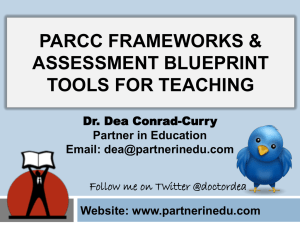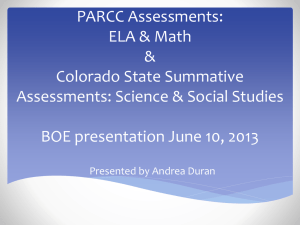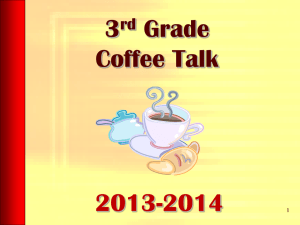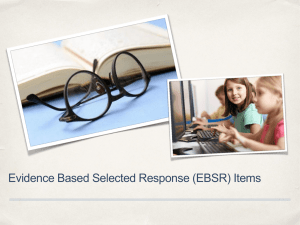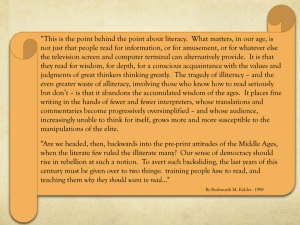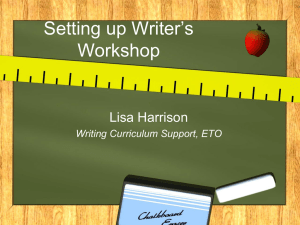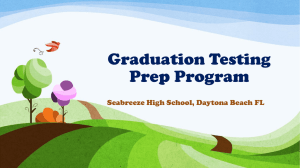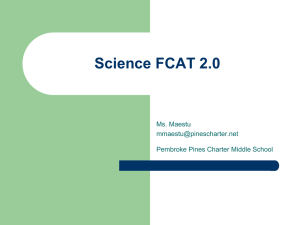Common_Core_State_Standards
advertisement
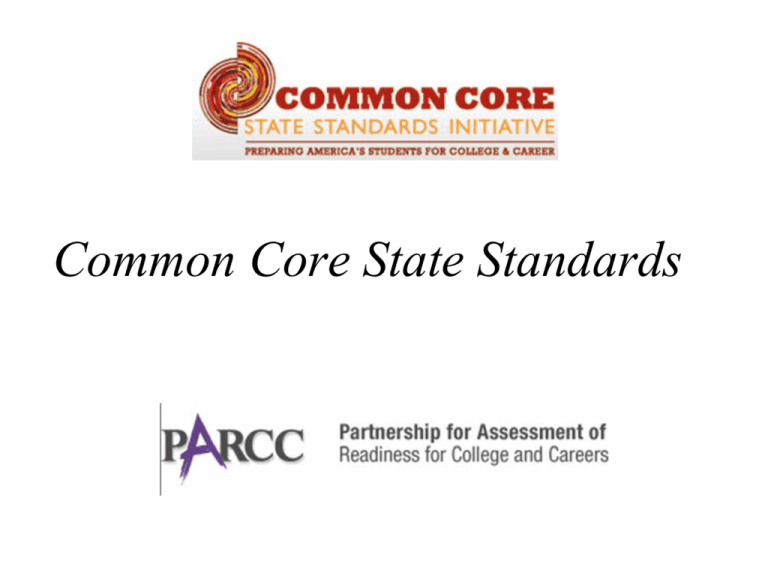
Common Core State Standards The Common Core State Standards: • Are aligned with college and work expectations; • Are clear, understandable and consistent; • Include rigorous content and application of knowledge through higher order skills • Build on strengths and lessons of current state standards; • Are informed by other top-performing countries, so that all students are prepared to succeed in a global economy and society; • Are evidence-based. Source: http://www.corestandards.org/about-the-standards A series published by Education Northwest to keep regional stakeholders informed about the Common Core initiative © iofoto/ Florida’s Common Core State Standards Implementation Timeline Year/Grade Level 2011-2012 K FL 1 L 2 L 3-8 L 9-12 L 2012-2013 FL FL L L L 2013-2014 FL FL FL BL BL FL FL FL FL FL CCSS fully implemented 2014-2015 CCSS fully implemented and assessed F - full implementation of CCSS for all content areas L - full implementation of content area literacy standards including: (1) text complexity, quality and range in all grades (K-12), and (2) CCSS Literacy Standards in History/Social Studies, Science, and Technical Subjects (6-12) B - blended instruction of CCSS with Next Generation Sunshine State Standards (NGSSS); last year of NGSSS assessed on FCAT 2.0 Handout Sort it out! Each Anchor Standard for reading can be defined “in a nutshell”. Identify standards 1-10 in its simplest form. “text based based evidence” evidence” in the Underline the “text standard that led you to that conclusion. Key Ideas and Details 1. Read closely to determine what the text says explicitly and to make logical inferences from it; cite specific textual evidence when writing and speaking to support conclusions drawn from the text. Understand and Prove it! 2. Determine central ideas or themes of a text and analyze their development; summarize the key supporting details and ideas. Main Idea 3. Analyze how and why individuals, events, and ideas develop and interact over the course of a text. “History Standard” Craft and Structure 4. Interpret words and phrases as they are used in a text, including determining technical, connotative, and figurative meanings, and analyze how specific word choices shape meaning or tone. Vocabulary Standard 5. Analyze the structure of texts, including how specific sentences, paragraphs, and larger portions of the text (e.g., a section, chapter, scene, or stanza) relate to each other and the words. Text Structure 6. Assess how point of view or purpose shapes the content and style of a text. Author’s Purpose Integration of Knowledge and Ideas 7. Integrate and evaluate content presented in diverse media and formats, including visually and quantitatively, as well as in words. Technology and Media (always in conjunction with text) 8. Delineate and evaluate the argument and specific claims in a text, including the validity of the reasoning as well as the relevance and sufficiency of the evidence. Argument with Evidence 9. Analyze how two or more texts address similar themes or topics in order to build knowledge or to compare the approaches the authors take. Text to Text Connection (use of multiple texts) Range of Reading and Level of Text Complexity 10. Read and comprehend complex literacy and informational texts independently and proficiently. Complex Text Note of range and content of student reading • To build a foundation for college and career readiness, students must read widely and deeply from among a broad range of high-quality, increasingly challenging literary and informational text. ELA: Standard 10 CCSS Literary Standard 10 Text complexity is defined by: 1. Quantitative measures – readability and other scores of text complexity often best measured by computer software. 2. Qualitative measures – levels of meaning, structure, language conventionality and clarity, and knowledge demands often best measured by an attentive human reader. 3. Reader and Task considerations – background knowledge of reader, motivation, interests, and complexity generated by tasks assigned often best made by educators employing their professional judgment. Reader and Task English Language Arts& Literacy in History/Social Studies, Science, and Technical Subjects Six Instructional Shifts 1. Balancing informational and literary texts 2. Knowledge in the Disciplines 3. Staircase of Complexity 4. Text-Based Answers 5. Writing From Sources 6. Academic Vocabulary What do these Shifts mean for Text Selection? • Texts must align with the complexity requirements outlined in standard 10. • All students, including those who are behind, must encounter and comprehend complex text • Materials should allow opportunities for close reading of selected passages. • There must be a variety and quality of text. Format for Grade Level Standards • Standards define what students should understand and be able to do. • Clusters are groups of related standards. Note that standards from different clusters may sometimes be closely related, because mathematics is a connected subject. • Domains are larger groups of related standards. Standards from different domains may sometimes be closely related. CCSS Reading the Standards http://www.corestandards.org/the-standards/mathematics/introduction/how-to-read-the-gradelevel-standards/ Standards for Mathematical Practice Make sense of problems and persevere in solving them Use appropriate tools strategically Reason abstractly and quantitatively Attend to precision Construct viable arguments and critique the reasoning of others Look for and make sense of structure Model with mathematics Look for and express regularity in repeated reasoning 25 Mathematics Progressions Project •Kindergarten Counting and Cardinality •Number and Operations in Base Ten •Number and Operations—Fractions •K–5 Operations and Algebraic Thinking •Measurement and Data •Geometry Progression (coming soon!) •Expressions and Equations •Ratios and Proportional Relationships •Statistics and Probability, Grades 6–8 http://commoncoretools.me/category/progressions/ 26 Math Domains for K-12 K 1 2 3 4 5 6 7 8 HS Counting and Cardinality (CC) Number and Operations in Base Ten (NBT) Number and Operations-Fractions (NF) The Number System Ratios and Proportional Relationships (RP) Number and Quantity Functions (F) Operations and Algebraic Thinking (OA) Expressions and Equations (EE) Algebra Geometry (G) Measurement and Data (MD) A-Z Statistics and Probability (SP) Times are Changing For More Information • • • • http://www.corestandards.org/ http://www.parcconline.org/ http://commoncore.org/maps/faqs http://www.corestandards.org/assets/Publish ers_Criteria_for_3-12.pdf • http://www.readinglady.com/index.php?mod ule=pagemaster&PAGE_user_op=view_page& PAGE_id=30&MMN_position=20:20 Lee County School District – October 2012 Who will take PARCC? 12-13 students impacted by PARCC 2012-2013 K & 1 Full CCSS implementation 2013-2014 K-2 Full CCSS implementation & 3-12 Blended NGSSS & CCSS 2014-2015 K-12 Full CCSS implementation Grade 1 Grade 2 Grade 3 Grade 2 Grade 3 – FCAT 2.0 Reading Grade 4 Grade 3 – FCAT 2.0 Reading Grade 4 – FCAT 2.0 Reading Grade 5 & FCAT 2.0 Writing Grade 4 – FCAT 2.0 Reading Grade 5 – FCAT 2.0 Reading Grade 6 & FCAT 2.0 Writing First group of students to assess on PARCC Literacy and Mathematics instead of FCAT 2.0 Reading, Writes, and Math Grade 5 – FCAT 2.0 Reading Grade 6 – FCAT 2.0 Reading Grade 7 Grade 6 – FCAT 2.0 Reading Grade 7 – FCAT 2.0 Reading Grade 8 Grade 7 – FCAT 2.0 Reading Grade 8 – FCAT 2.0 Reading Grade 9 & FCAT 2.0 Writing Grade 8 – FCAT 2.0 Reading Grade 9 – FCAT 2.0 Reading Grade 10 & FCAT 2.0 Writing Grade 9 – FCAT 2.0 Reading Grade 10 – FCAT 2.0 Grade 11 Reading & FCAT 2.0 Writing Lee County School District – October 2012 Checkpoints Summative Assessment Components: –Performance-Based Assessment (PBA) –End-of-Year Assessment (EOY) Formative Assessment Components: –Early Assessment –Mid-Year Assessment The PARCC Picture: Formative & Summative Flexible Optional Assessments Early Assessment • Early indicator of student knowledge and skills to inform instruction, supports, and PD Summative assessment for accountability 33 Mid-Year Assessment • Performance-based • Emphasis on hard to measure standards Formative assessment Performance-Based Assessment (PBA) • Extended tasks • Applications of concepts and skills End-of-Year Assessment • Innovative, computerbased items Speaking & Listening Assessment Lee County School District – October 2012 Formative/Non-Summative Lee County School District – October 2012 Summative Lee County School District – October 2012 A look at some sample items for the Tasks Lee County School District – October 2012 Performance-Based Assessment (PBA) writing effectively, when analyzing text • Literary Analysis Task • Narrative Task • Research Simulation Task Performance-Based Assessment (PBA) writing effectively, when analyzing text Literary Analysis Task: –important role in honing students’ ability to read complex text closely. –will ask students to carefully consider literature worthy of close study and compose an analytic essay. Lee County School District – October 2012 Performance-Based Assessment (PBA) writing effectively, when analyzing text Narrative Task: – broadens the way in which students may use this type of writing. Narrative writing can be used to convey experiences or events, real or imaginary. – students may be asked to write a story, detail a scientific process, write a historical account of important figures, or to describe an account of events, scenes or objects, for example. Lee County School District – October 2012 Performance-Based Assessment (PBA) writing effectively, when analyzing text Research Simulation Task: – an assessment component worthy of student preparation because it asks students to exercise the career- and college- readiness skills of observation, deduction, and proper use and evaluation of evidence across text types. – students will analyze an informational topic presented through several articles or multimedia stimuli, the first text being an anchor text that introduces the topic. Students will engage with the texts by answering a series of questions and synthesizing information from multiple sources in order to write two analytic essays. Lee County School District – October 2012 End-of-Year Assessment (EoY) Students will be given several passages to read closely (possibly six texts – one may be multimedia). EBSR and TECR questions will be sequenced in a way that they will draw students into deeper encounters with the texts and will result in thorough comprehension of the concepts to provide models for the regular course of instruction. Will draw on higher order skills such as critical reading and analysis, the comparison and synthesis of ideas within and across texts, and determining the meaning of words and phrases in context. Lee County School District – October 2012 Grade 10 End-of-Year Assessment Evidence-Based Selected-Response Literary Analysis •Part Evidence-Based Selected Response (EBSR) A •Which Technology Enhanced Constructed Response of the following sentences best states an (TECR) theme about human behavior as described in important Ovid’s “Daedalus and Icarus”? a.Striving to achieve one’s dreams is a worthwhile endeavor. b.The thoughtlessness of youth can have tragic results.* c.Imagination and creativity bring their own rewards. d.Everyone should learn from his or her mistakes. RL.10.1 (evidence); RL.10.2 (theme); RL.10.10 (complex text) Lee County School District – October 2012 Grade 10 End-of-Year Assessment Evidence-Based Selected-Response • Evidence-Based Selected Response (EBSR) Literary Analysis Part B Select pieces of evidenceEnhanced from Ovid’s “Daedalus and Icarus” that support the answer to Part A. • three Technology Constructed Response a. “and by his playfulness retard the work/his anxious father planned” (lines 310-311)* (TECR) b. “But when at last/the father finished it, he poised himself” (lines 312-313) c. “he fitted on his son the plumed wings/ with trembling hands, while down his withered cheeks/the tears were falling” (lines 327-329) d. “Proud of his success/the foolish Icarus forsook his guide” (lines 348-349)* e. “and, bold in vanity, began to soar/rising above his wings to touch the skies” (lines 350-351)* f. “and as the years went by the gifted youth/began to rival his instructor’s art” (lines 376-377) g. “Wherefore Daedalus/enraged and envious, sought to slay the youth” (lines 384-385) h. “The Partridge hides/in shaded places by the leafy trees…for it is mindful of its former fall” (lines 395-396, 399) Grade 10 End-of-Year Assessment Evidence-Based Selected-Response A •PartEvidence-Based Selected Response (EBSR) What does the word vanity mean in these lines from the text “Daedalus and •Icarus”? Technology Enhanced Constructed Response “Proud of his success, the foolish Icarus forsook his guide, and, bold in vanity, began to soar” (lines 345-349) (TECR) a. arrogance* Literary Analysis: b. fear c. heroism Vocabulary d. enthusiasm Part B Which word from the lines from the text in Part A best helps the reader understand the meaning of vanity? a. proud* b. success RL.10.1 (evidence); RL.10.4 (meaning of words and phrases); RL.10.10 (complex texts) c. foolish Lee County School District – October 2012 d. soar Grade 10 End-of-Year Prose Assessment Constructed Response #2 • Evidence-Based Selected Response (EBSR) Literary Analysis • Technology Enhanced Constructed Response Use what you have learned from reading “ Daedalus and (TECR) Icarus ” by Ovid and “ To a Friend Whose Work Has Come to Triumph ” by Anne Sexton to write an essay that analyzes how Icarus’s experience of flying is portrayed differently in the two texts. Develop your essay by providing textual evidence from both texts. Be sure to follow the conventions of standard English. RL.10.1; RL.10.9; W.10.2; W.10.4; L.10.1-3 (grammar and conventions) Lee County School District – October 2012 Grade 6 End-of-Year Assessment Evidence-Based Selected-Response Part A • Evidence-Based Selected Response (EBSR) What does the word “regal” mean as it is used in the passage? generous •a. Technology Enhanced Constructed Response b. threatening (TECR) c. kingly* d. uninterested Narrative: Vocabulary Part B Which of the phrases from the passage best helps the reader understand the meaning of “regal?” a. “wagging their tails as they awoke” b. “the wolves, who were shy” c. “their sounds and movements expressed goodwill” d. “with his head high and his chest out”* RL.6.1 (evidence); RL.6.4 (meaning of words and phrases); RL.6.10 (complex text) Lee County School District – October 2012 Grade 6 End-of-Year Assessment Evidence-Based Selected-Response • Evidence-Based Selected Response (EBSR) • Technology Enhanced Constructed Response Narrative (TECR) Part A Based on the passage from Julie of the Wolves, how does Miyax feel about her father? a. She is angry that he left her alone. b. She blames him for her difficult childhood. c. She appreciates him for his knowledge of nature.* d. She is grateful that he planned out her future. Part B Which sentence from the passage best shows Miyax’s feelings for her father? a. “She had been lost without food for many sleeps on the North Slope of Alaska.” b. “This could be done she knew, for her father, an Eskimo hunter, had done so.”* c. “Unfortunately, Miyax’s father never explained to her how he had told the wolf of his needs.” d. “And not long afterward he paddled his kayak into the Bering Sea to hunt for seal, and he never returned.” RL.6.1 (evidence); RL.6.3 (how characters respond); RL.6.10 (complex text) Lee County School District – October 2012 Grade 6 End-of-Year Assessment Technology-Enhanced Constructed-Response Lee County School District – October 2012 • Evidence-Based Selected Response (EBSR) Part A •Choose Technology Enhanced Response one word that describes Constructed Miyax based on evidence from the(TECR) text. There is more than one correct choice listed below. A. B. C. D. E. F. reckless lively imaginative* observant* impatient confident Narrative RL.6.1 (evidence); RL.6.3 (how characters respond); RL.6.10 (complex text) Grade 6 End-of-Year Assessment Technology-Enhanced Constructed-Response Lee County School District – October 2012 •PartEvidence-Based Selected Response (EBSR) Narrative B • Technology Constructed Response Find a sentence in Enhanced the passage with details that support your response to Part A. Click on that sentence and drag and drop it (TECR) into the box below. Part C Find a second sentence in the passage with details that support your response to Part A. Click on that sentence and drag and drop it into the box below. RL.6.1 (evidence); RL.6.3 (how characters respond); RL.6.10 (complex text) Grade 6 End-of-Year ProseAssessment Constructed Response Evidence-Based Selected Response In •the passage, the author developed a strong(EBSR)Narrative character named Miyax. ThinkConstructed about Miyax and the • Technology Enhanced Response details the author used to create that character. The (TECR) passage ends with Miyax waiting for the black wolf to look at her. Write an original story to continue where the passage ended. In your story, be sure to use what you have learned about the character Miyax as you tell what happens to her next. RL.6.1 (evidence); RL.6.3 (describe how characters respond to changes); RL.6.10 (complex text); W.6.3 (narrative writing); W.6.4 (writing coherently); L.6.1-3 (grammar and conventions) Lee County School District – October 2012 Grade 7 End-of-Year ProseAssessment Constructed Response Research Simulation: Summary • Evidence-Based Selected Response (EBSR) • Technology Enhanced Constructed Response Based on the information in the text “Biography of (TECR) Amelia Earhart,” write an essay that summarizes and explains the challenges Earhart faced throughout her life. Remember to use textual evidence to support your ideas. RI.7.1 (evidence); RI.7.2 (summary of text); RI.7.10 (complex texts); W.7.2 (writing to explain or inform); W.7.4 (writing coherently); W.7.9 (drawing evidence from texts); L.7.1-3 (grammar and conventions) Lee County School District – October 2012 Grade 7 End-of-Year Assessment Technology-Enhanced Constructed-Response • Evidence-Based Selected Response (EBSR) • Technology Enhanced Constructed Response Research (TECR) Below are three claims that one could make based on the article “Earhart’s Final Resting Place Believed Found.” Simulation Part A •Highlight the claim that is supported by the most relevant and sufficient facts within “Earhart’s Final Resting Place Believed Found.” Part B •Click on two facts within the article that best provide evidence to support the claim selected in Part A. RI.7.1 (evidence); RI.7.8 (author’s claims and evidence); Lee County School District – October 2012 RI.7.10 (complex texts) Grade 7 End-of-Year ProseAssessment Constructed Response • Evidence-BasedResearch SelectedSimulation: Response (EBSR)Essay Analytic You have read three texts describing Amelia Earhart. All three include the claim • Technology Enhanced Constructed Response that Earhart was a brave, courageous person. The three texts are: (TECR) Lee County School District – October 2012 • “Biography of Amelia Earhart” • “Earhart's Final Resting Place Believed Found” • “Amelia Earhart’s Life and Disappearance” Consider the argument each author uses to demonstrate Earhart’s bravery. Write an essay that analyzes the strength of the arguments about Earhart’s bravery in at least two of the texts. Remember to use textual evidence to support your ideas. RI.7.1 (evidence); RI.7.8 (evaluate claims in a text); RI.7.9 (comparison of authors’ presentation); RI.7.10 (complex texts); W.7.2 (writing to inform and explain); W.7.4 (writing coherently); W.7.7 (conduct short research projects); W.7.8 (gather relevant information from multiple sources); W.7.9 (drawing evidence from texts); L.7.1-3 (grammar and conventions) Grade 3 End-of-Year Assessment Evidence-Based Selected-Response B A •PartEvidence-Based SelectedPart Response (EBSR) •What Technology Constructed Response Which sentence from the article best is one main ideaEnhanced of “How supports the answer to Part A? Animals Live?” (TECR) a. There are many types of animals on the planet. b. Animals need water to live. c. There are many ways to sort different animals.* d. Animals begin their life cycles in different forms. a. “Animals get oxygen from air or water.” b. "Animals can be grouped by their traits.”* c. "Worms are invertebrates.” d. "All animals grow and change over time.” e. "Almost all animals need water, food, oxygen, and shelter to live." RI.3.1 (evidence); RI.3.2 (main idea); RI.3.10 (complex text) Lee County School District – October 2012 Grade 3 End-of-Year Assessment Technology-Enhanced Constructed-Response •Drag Evidence-Based Response the words from theSelected word box into the correct(EBSR) locations on • Technology the graphic to showEnhanced the life cycleConstructed of a butterfly as Response described in (TECR) “How Animals Live.” Words: Pupa Adult Egg Larva RI.3.1 (evidence); RI.3.3 (relationship between events); RI.3.10 (complex text) Lee County School District – October 2012 How will PARCC be administered? • constructed response items • performance-based tasks • computer-enhanced, computer-scored items. Administered via computer with a combination of automated and human scoring Beginning in Gr. 3, students will type responses on the computer Three Item Types – Prose Constructed Response (PCR) – Evidence-Based Selected Response (EBSR) – Technology Enhanced Constructed Response (TECR) Lee County School District – October 2012 How will student’s be scored? Performance Level Descriptors: there will be five performance levels Student results will be reported according to numerical scaled scores and performance levels. Each PARCC performance level will have a specified minimum scaled score associated with it – often referred to as cut score. Cut scores for PARCC performance levels will be determined through a systematic, standard-setting process in the summer of 2015. Lee County School District – October 2012 Stay Current • http://tinyurl.com/PARCC-K-12-Survey Sign up for PARCC’s newsletter to stay in the loop on PARCC’s design and development activities and upcoming events Lee County School District – October 2012 References • www.fldoe.org/parcc • PARCC ITN Test Blueprint • www.parcconline.org Lee County School District – October 2012
